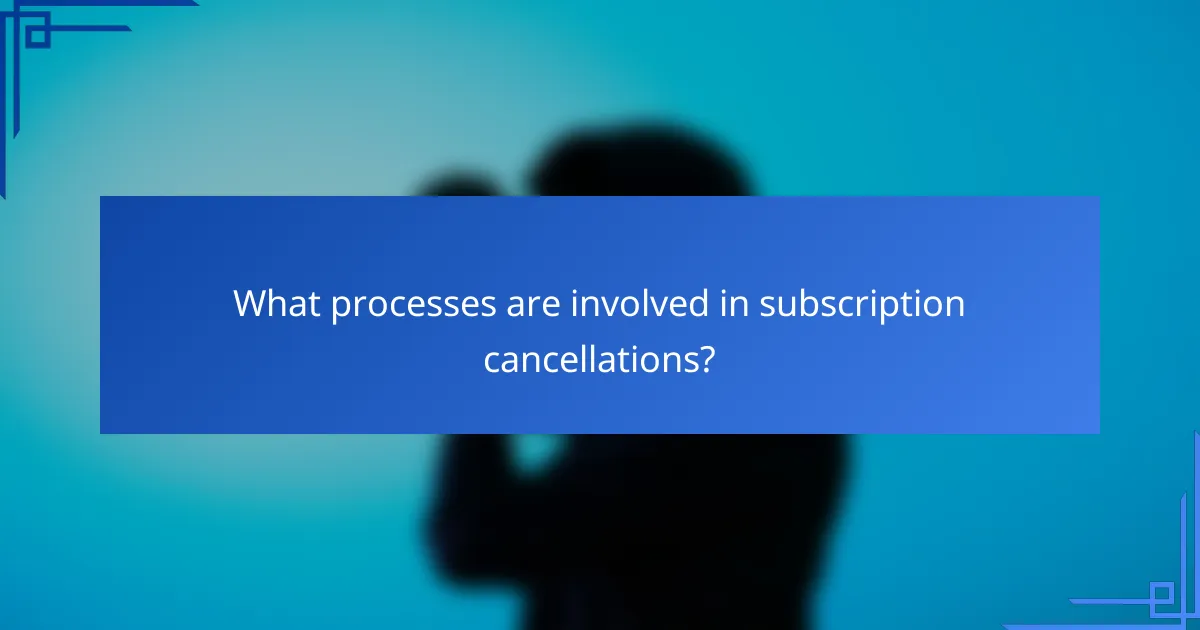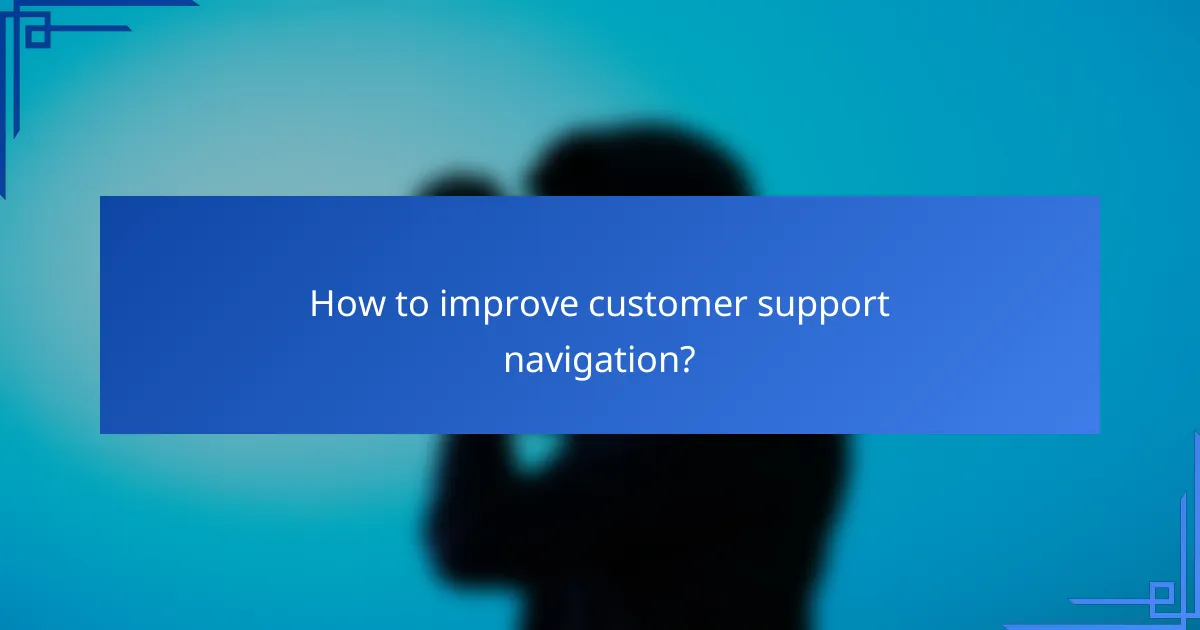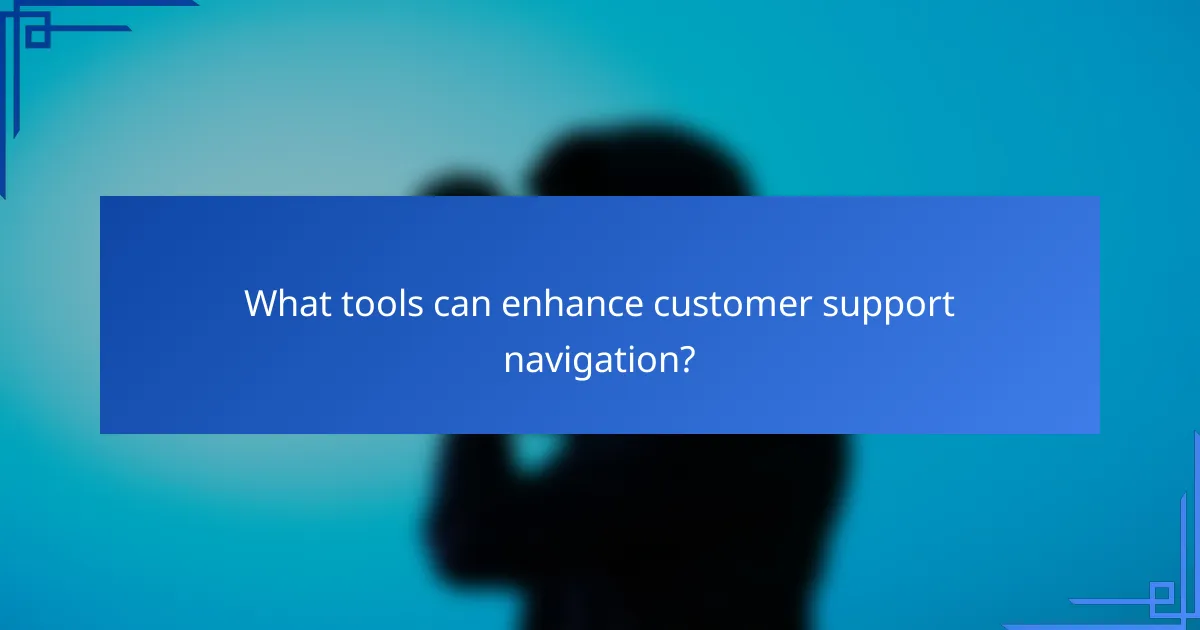Navigating customer support for cancellations can be straightforward when you understand the available options and processes. Whether you choose to cancel online, via phone, or through email, being informed about the necessary steps can enhance your experience and minimize potential issues. Clear communication and a customer-focused approach are essential for effective cancellation handling, ensuring that your request is processed smoothly and efficiently.

How to navigate customer support for cancellations in the UK?
Navigating customer support for cancellations in the UK involves understanding the available options and processes. Whether you prefer online methods, phone support, or email requests, knowing the steps can streamline your experience and help you avoid common pitfalls.
Online cancellation options
Many companies in the UK offer online cancellation options through their websites or mobile apps. This method is often the quickest, allowing you to complete the process at your convenience without waiting for assistance.
To use online cancellation, log into your account, locate the order or service you wish to cancel, and follow the prompts. Be sure to check for any cancellation policies that may apply, such as deadlines or potential fees.
Phone support for cancellations
Phone support is another effective way to handle cancellations in the UK. Calling customer service can provide immediate assistance and clarification on any questions you may have regarding the cancellation process.
When using phone support, have your account details and any relevant information ready to expedite the call. Be aware that wait times can vary, so calling during off-peak hours may reduce your wait time.
Email cancellation requests
Submitting an email cancellation request is a viable option if you prefer written communication. This method allows you to document your request and provides a record of your correspondence.
When sending an email, include your account information, details of the service or order, and a clear statement requesting cancellation. Keep your message concise and professional to facilitate a prompt response.

What are the best practices for handling cancellations?
Effective cancellation handling requires clear communication, timely responses, and a customer-centric approach. Implementing best practices can enhance customer satisfaction and reduce frustration during the cancellation process.
Clear communication guidelines
Establishing clear communication guidelines is essential for managing cancellations. Ensure that customers know the cancellation policy, including any fees or deadlines, through multiple channels such as email, website FAQs, and customer service scripts.
Use straightforward language to explain the process. For instance, if a customer needs to cancel a subscription, provide step-by-step instructions on how to do so, including any necessary contact information or online forms.
Regularly review and update communication materials to reflect any changes in policies. This helps maintain transparency and builds trust with customers.
Timely response protocols
Timely responses are crucial when handling cancellations. Aim to acknowledge cancellation requests within a few hours and provide a resolution within one business day. This quick turnaround can significantly improve customer satisfaction.
Implement a tracking system to monitor cancellation requests and responses. This allows your team to prioritize urgent cases and ensures that no requests are overlooked. Consider using automated responses to confirm receipt of cancellation requests.
Train your support staff to handle cancellations efficiently. Equip them with the necessary tools and information to address customer concerns promptly, which can help mitigate potential dissatisfaction.

What processes are involved in subscription cancellations?
Subscription cancellations typically involve a series of steps that ensure the customer’s request is processed efficiently. These processes may vary by service provider but generally include initiating the cancellation, verifying the customer’s identity, and confirming the cancellation status.
Step-by-step cancellation process
The cancellation process usually begins with the customer accessing their account settings on the service provider’s website or app. From there, they can locate the subscription management section and select the option to cancel their subscription.
After initiating the cancellation, the customer may receive a confirmation prompt asking them to verify their decision. This may include information about any remaining billing cycles or potential fees associated with early cancellation.
Finally, once the cancellation is confirmed, the customer should receive an email or notification confirming that their subscription has been successfully canceled, along with any relevant details about the end date of service.
Verification requirements
To ensure the security of the cancellation process, service providers often require verification of the customer’s identity. This may involve entering a password, answering security questions, or providing a verification code sent via email or SMS.
Some providers may also require additional information, such as the last four digits of the payment method used for the subscription. This step helps prevent unauthorized cancellations and protects both the customer and the service provider.
Customers should be prepared to provide this information promptly to avoid delays in processing their cancellation request. Failing to meet verification requirements can result in the cancellation being denied or postponed.

How to improve customer support navigation?
Improving customer support navigation involves creating intuitive pathways for users to find the information they need quickly and efficiently. This can be achieved through thoughtful website design and comprehensive FAQ sections that address common inquiries.
User-friendly website design
A user-friendly website design is crucial for effective customer support navigation. It should feature clear menus, logical categorization of information, and a responsive layout that works well on both desktop and mobile devices. Consider using a simple color scheme and readable fonts to enhance visibility.
Incorporate search functionality that allows users to quickly locate specific topics or questions. A well-structured site map can also guide users to important sections without frustration. Regularly test the design with real users to identify pain points and areas for improvement.
Effective FAQ sections
An effective FAQ section serves as a self-service resource for customers, reducing the need for direct support interactions. Organize FAQs by categories such as account management, billing, and technical issues to help users navigate easily. Each question should be concise and directly address common concerns.
Consider including a search bar within the FAQ section to allow users to type in keywords. Additionally, updating FAQs regularly based on customer feedback and emerging issues can keep the content relevant and useful. Providing links to related articles or support channels can further enhance the user experience.

What metrics should be tracked for customer support effectiveness?
To assess customer support effectiveness, key metrics include response time and customer satisfaction ratings. Tracking these metrics helps organizations identify areas for improvement and enhance overall service quality.
Response time analysis
Response time analysis measures how quickly customer support teams address inquiries. A typical benchmark for effective response times is within a few minutes for live chat and under a few hours for email support. Monitoring these times can reveal trends and help set realistic expectations for customers.
Consider using automated tools to track and analyze response times. This data can highlight peak hours when support may be overwhelmed, allowing for better staffing and resource allocation. Aim for a consistent response time to improve customer trust and satisfaction.
Customer satisfaction ratings
Customer satisfaction ratings gauge how well support meets customer needs. Surveys typically ask customers to rate their experience on a scale, often from 1 to 5 or 1 to 10. Regularly collecting and analyzing this feedback can provide insights into service quality and areas needing attention.
To enhance customer satisfaction, implement follow-up surveys after support interactions. Look for trends in feedback to identify common issues or strengths. Aim for a satisfaction rate above 80% to indicate effective support, but always strive for continuous improvement based on customer input.

How do different subscription services handle cancellations?
Subscription services vary in their cancellation processes, often allowing users to cancel online, through apps, or via customer support. Understanding these processes can help users avoid unexpected charges and ensure a smooth transition away from the service.
Netflix cancellation process
To cancel a Netflix subscription, users can log into their account on the Netflix website or app. Once logged in, they should navigate to the “Account” section and select “Cancel Membership.” The cancellation takes effect immediately, and users can continue to access content until the end of their billing cycle.
Netflix does not impose cancellation fees, making it straightforward for users to stop their subscriptions. However, it’s advisable to cancel before the next billing date to avoid being charged for the upcoming month.
Amazon Prime cancellation options
Amazon Prime members can cancel their subscriptions through the Amazon website or app. After signing in, they should go to “Your Account,” select “Prime Membership,” and then choose “End Membership.” Users will receive a confirmation of their cancellation, and they can continue to enjoy Prime benefits until the end of their current billing period.
Amazon offers a unique feature where users can choose to pause their membership instead of canceling it entirely. This option allows members to temporarily halt their subscription for a specified duration, which can be useful if they anticipate needing the service again soon.

What tools can enhance customer support navigation?
Effective customer support navigation can be significantly improved with the right tools. Utilizing live chat software and helpdesk ticketing systems can streamline communication and enhance the overall customer experience.
Live chat software
Live chat software allows customers to engage with support representatives in real-time, providing immediate assistance. This tool is particularly effective for addressing urgent inquiries, as response times are typically low, often within seconds.
When selecting live chat software, consider features like chatbots for initial queries, integration with existing systems, and analytics for tracking performance. Popular options include Zendesk Chat and Intercom, which offer user-friendly interfaces and robust functionality.
To maximize effectiveness, ensure that live chat is easily accessible on your website and that representatives are trained to handle common issues efficiently. Avoid long wait times, as this can frustrate customers and lead to dissatisfaction.
Helpdesk ticketing systems
Helpdesk ticketing systems organize customer inquiries into manageable tickets, allowing support teams to track and resolve issues systematically. This approach ensures that no requests are overlooked and that customers receive timely updates on their inquiries.
When implementing a ticketing system, look for features such as automated ticket routing, priority tagging, and reporting capabilities. Tools like Freshdesk and Jira Service Management are popular choices that cater to various business sizes and needs.
To enhance the ticketing process, establish clear guidelines for response times and resolution procedures. Regularly review ticket data to identify trends and areas for improvement, ensuring that your support team can adapt to changing customer needs effectively.

What emerging trends are shaping customer support navigation?
Emerging trends in customer support navigation are increasingly focused on enhancing user experience through technology and personalization. Key developments include the integration of AI-driven solutions, omnichannel support, and proactive customer engagement strategies.
AI-driven support solutions
AI-driven support solutions utilize machine learning and natural language processing to improve customer interactions. These technologies can automate responses to common inquiries, reducing wait times and freeing up human agents for more complex issues.
Implementing AI chatbots can lead to significant efficiency gains. For instance, businesses often report that chatbots can handle up to 70% of routine queries, allowing customer support teams to focus on higher-value tasks. However, it’s crucial to ensure that these systems are well-trained to avoid misunderstandings.
When adopting AI solutions, consider the balance between automation and human touch. While AI can streamline processes, maintaining a human element is essential for complex or sensitive issues. Regularly review and update AI training data to keep responses relevant and accurate.
